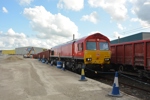Jim Steer,
Founder and Director,
Steer Davies Gleave
As things stood on May 3, the EU referendum was a dead heat - 50/50 - based on the average of the last six polls. Of course, polls cannot be considered reliable on these matters (think Scottish Independence vote, 2014), and there are many in the ‘don’t know’ or even ‘don’t care’ camp. Others say they want more information.
At least as far as the rail sector is concerned, the facts and the issues facing the industry in relation to the EU are well documented. But either way, a close result will create new challenges for rail.
If the vote is ‘leave’, we know that the provision for setting the terms of exit are time limited (two years) and will be determined by the EU. Given the other major issues it faces, especially the migrant crisis, the EU will be keen to show that the price of exit will be painful.

After all, the UK is not alone in having political parties campaigning for break-up. This is a testing time for the European project, and the UK will have been seen to have abandoned ship. If the vote is ‘remain’, with (if it happens) what seems likely to be a slender margin, the outlook won’t be plain sailing either. The ‘remain’ campaign has centred on a re-run of the unionist ‘Project Fear’ approach taken in Scotland two years ago. It may well be that all of the economic indicators and institutions point to a damaging outcome from a leave decision (and pretty much without exception, they do), but little has been made of the positive benefits of EU membership.
‘Remaining’, even with a narrow yes vote, may well bring a sigh of relief from many in the rail industry. But it can’t deliver the status quo ante. Instead there will be a divided UK (Conservative) Government facing a hostile press that has never bothered to step outside the Westminster village and report sensibly on EU matters. The daily diet of anti-EU rhetoric will remain, and (just as has happened in Scotland, where the SNP remains dominant) resentment about the fear campaign will continue.
The strength of the UK economy, consumer confidence, business confidence, a positive image to the outside world to attract tourism, and so on - these things all matter to the UK rail industry, which has become accustomed to growth. Growth drives investment. But in the post-referendum world, this is at risk.
Actually, the UK rail industry is a good example of a beneficiary of EU membership. The best chance of restoring the rail supply sector to international pre-eminence relies on domestic growth driving investment, with new products and innovation in turn creating competitive advantage. What has happened in the UK with a resurgent automotive sector can happen with rail, too. But surely not as easily with trade barriers and tariffs in Europe.
But don’t take my word for it: look at the evidence pieced together by the DfT and published in 2014 (Review of the balance of competences between the United Kingdom and the European Union: Transport, February 13 2014).
This was the transport component of an across-the-board government review set in train in December 2012, well before a decision was taken to hold a referendum on EU membership. The main messages from evidence sent in by transport stakeholders were “general support for liberalised free trade in the EU… a desire for this to go further… and frustration where this aspiration has been held back by ineffective implementation or lack of enforcement of existing regulation.”
The review of competence was concerned with everything deriving from EU law that affects what happens in the UK. On transport, DfT concluded from the evidence that “stakeholders broadly wanted the EU to focus on implementing the existing laws which underpin the Single Market”, rather than to seek new legislation.
It continued: “While stakeholders recognised the value of common operating and technical product standards, for example in manufacturing and rail interoperability, and that these would not exist across the EU without EU action, there was some concern at the perceived use of common standards in other fields, such as safety or social policy, to claw back market freedoms and allow the potential imposition of national barriers, possibly in a protectionist way.”
It summed up these views saying: “While the concept of the Single Market in transport services is generally strongly supported, so too are the principles of subsidiarity and proportionality.”
In putting together its report, DfT looked in depth at how the EU’s competences (the power to act in particular areas conferred on it by the EU Treaties) work in practice. It looked at crucial areas such as:
■ The Single Market for transport services.
■ Enforcement and Implementation.
■ EU representation in international organisations.
■ Common standards.
■ Operating and technical product standards.
■ Consumer, social and environmental standards.
The facts of operating within an EU framework on a daily basis are helpfully spelled out in an accompanying document of consultation responses (you can read it at http://bit.ly/23Zyvok). In it you can see and contrast the views of (say) ATOC and ASLEF - one keen on market liberalisation, the other not; one wary of the ‘social chapter’, the other welcoming it with open arms. You can see reactions to specific EU measures - for example, that ATOC was content with EU regulations on consumer protection and on the rights of passengers with reduced mobility.
Looking at operators, the benefits of EU membership to a company such as Eurostar are perhaps obvious. For the freight sector it is more complicated, as set out in a lengthy exposition by the Rail Freight Group - the ideals of the single market are far from being grasped as yet. But Freightliner nevertheless makes clear that: “It is helpful that measures such as raising standards and safety are set out at EU level.”
Of course, it’s not all positive. There is much frustration that market liberalisation is not creating a level playing field, because of blocking tactics at national government levels.
Hence the general plea for more enforcement. Open access passenger operator HKX (Hamburg Köln Express) spells out the facts of these challenges and what needs to be done to overcome them.
From Network Rail there is a clear exposition on how it inter-relates with European bodies, distinguishing between Membership (European Rail Infrastructure Managers), Involvement (for example, the ERA) and Interfaces. Indeed, what becomes clear reading its submission is that the UK rail industry has been very active in EU negotiations and policy setting. Rail is a sector where the UK leads in Europe in so many respects, and our opinions and approaches are admired and welcomed.
As the ORR submission to the Competence Review says: “The EU vision for rail, as laid out in the 2011 White Paper, is compatible with our strategic objectives. The UK was one of the first Member States to reform and liberalise its institutional framework for rail.
As a result, UK domestic regulatory policy has often served as the starting point for EU proposals.
“The introduction of the European rail packages has been strategically positive for the UK rail freight and passenger market, contributing to a more liberalised sector where rail traffic has grown its market share. The introduction of common technical standards has also contributed to optimising the supply market in GB, allowing the rail industry to take advantage of wider and more innovative technical solutions,”
ORR goes on to say: “ORR has some concerns over the pace of EU legislation. Where progress in the sector is slow, this is not necessarily due to insufficient legislation, but may be due to inadequate implementation in Member States of the existing law.”
And Network Rail again: “There is an opportunity for Member States to redress any imbalance of power and any lack of clarity in the secondary legislative process through transposition into national law. Currently the Government operates a policy of ‘copy-out’ for transposition meaning that opportunities to interpret EU legislation, and take advantage of flexibility in the texts, are not actively sought by the UK. Although transposition is a last-resort mechanism available to redress any anomalies which may upset the balance, we believe it is a process which should receive a lot more emphasis and be taken as an opportunity to round some of the potentially sharp edges of European legislation.”
While the rail sector may lead in the EU, and work effectively to ensure the sector gets the benefits and avoids the pitfalls of EU-membership (the ORR speaks of having played a central role), it does so in a context of wider government reluctance to engage.
Government rarely mentions the positive side of EU participation. The blossoming of rail over the last 20 years - its top scores in Europe for passenger volume growth and for overall safety; strong investment programmes; a resurgent and competitive rail supply sector - have all coincided with the period of applying EU-based directives and regulations, in the drafting of which the UK has played an active role. The EU story on rail is very different to the national debate between our politicians.
Perhaps they should be told.
- We'll be posting more on the EU Referendum in the next couple of days so keep checking back to find out more.

















Login to comment
Comments
No comments have been made yet.